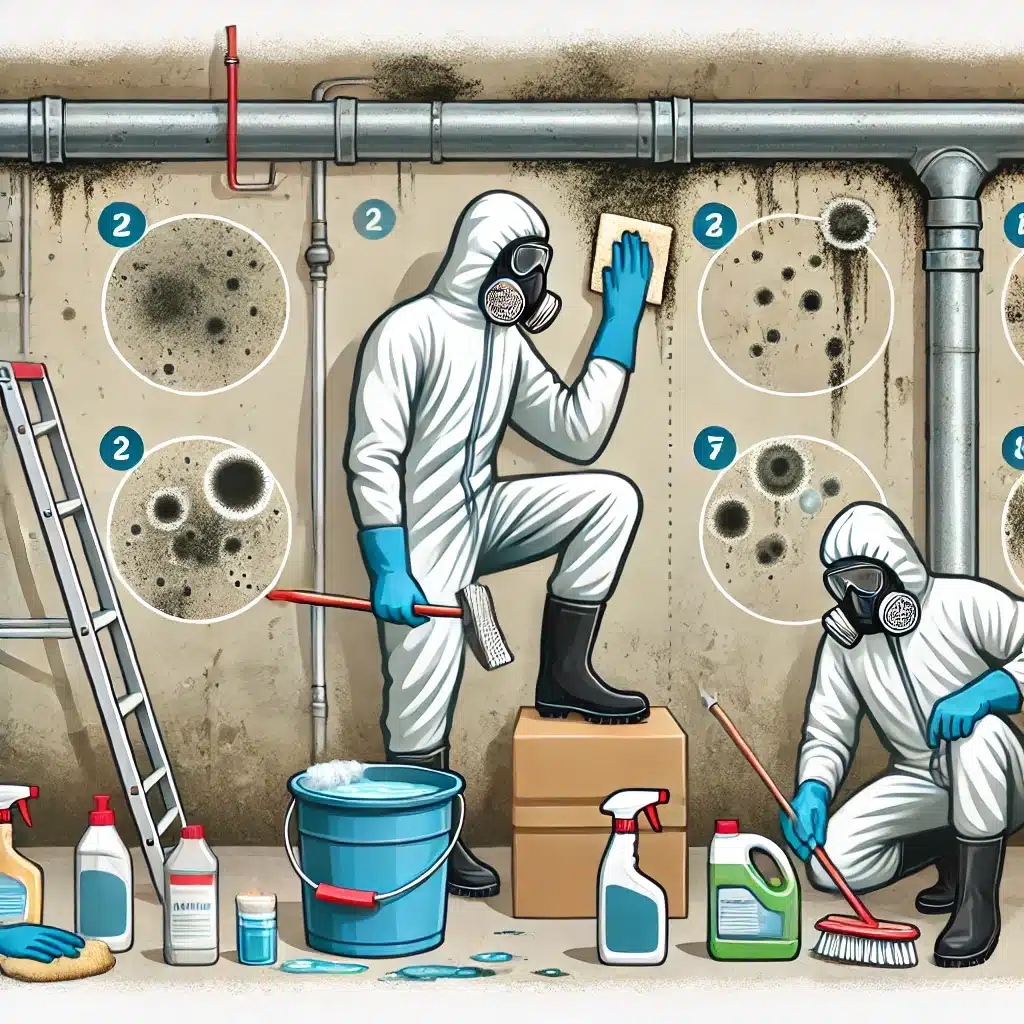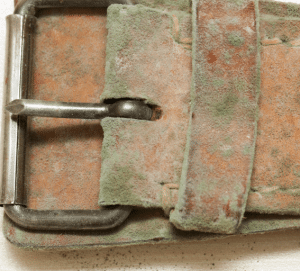Dealing with mold in the basement? You’re not alone! Basements are notorious for mold growth because of their damp, dark, and often poorly ventilated conditions. But don’t worry, tackling this issue is easier than you might think.
In this guide, you’ll find step-by-step instructions on how to get rid of mold from different surfaces in your basement. We’ll cover various cleaning agents and methods, including mold testing, ensuring you have all the information you need to handle this common household problem effectively.
So, whether you’re dealing with mold on walls, floors, or other surfaces, we’ve got you covered. By the end of this guide, you’ll be well-equipped to make your basement a cleaner, healthier space. Let’s dive in and say goodbye to that pesky mold!
Common Areas Where Mold Grows in Your Basement
Mold in the basement is a frequent problem due to the damp and often poorly ventilated-environment. Understanding where mold is likely to grow can help you target your cleaning and prevention efforts effectively. Here are some common areas where mold tends to thrive in basements:
Walls and Corners
Basement walls, especially those made of concrete or drywall, are prime locations for mold growth. The combination of moisture seeping through the walls and limited air circulation creates an ideal environment for mold spores to settle and multiply.
Floors and Carpets
If your basement has a carpeted floor, it can easily become a breeding ground for mold. Carpets can trap moisture from spills, leaks, or condensation, providing a perfect habitat for mold. Even non-carpeted floors can harbor mold, especially in areas where water tends to pool.
Ceiling and Insulation
Mold can grow on basement ceilings, particularly if there is a leak from the plumbing or roof above. Insulation materials are also susceptible to mold growth if they become damp, often going unnoticed until a significant problem has developed.
Windows and Window Sills
Basement windows can be sources of moisture through condensation, leaks, or inadequate sealing. Mold often grows around the frames and on the sills where water can collect and remain undisturbed for extended periods.
HVAC Systems and Vents
Mold can develop inside HVAC systems and vents due to the moisture and dust they collect. When these systems are used, they can spread mold spores throughout the basement and the rest of the house, exacerbating the problem.
Storage Areas and Furniture
Stored items and furniture in the basement, especially those made from organic materials like wood, fabric, or paper, are vulnerable to mold. These items can absorb moisture from the air, creating a hospitable environment for mold growth.
Tools & Materials
To effectively remove mold from your basement, having the right tools and materials is crucial. Each item plays a specific role in ensuring a thorough and safe cleaning process. Here’s a rundown of what you’ll need and why each is important:
Protective Gear
- Gloves, N95 Mask, Safety Goggles: Personal protection is paramount when dealing with mold. Gloves protect your skin, an N95 mask prevents inhalation of mold spores, and safety goggles shield your eyes from splashes.
Cleaning Agents
- Hydrogen Peroxide: A powerful disinfectant, hydrogen peroxide is effective at killing mold and brightening surfaces.
- Borax: This natural mineral is excellent for cleaning and preventing mold regrowth due to its antifungal properties.
- Bleach: A strong mold killer, bleach is best for non-porous surfaces but should be used with caution due to its harshness and fumes.
- White Vinegar: Vinegar is a mild acid that can kill mold on porous and non-porous surfaces and prevent it from returning.
- Tea Tree Oil: Known for its natural antifungal properties, tea tree oil is an eco-friendly mold remover that works well in diluted form.
Application Tools
- Spray Bottles: These are essential for applying cleaning solutions evenly across moldy surfaces.
- Soft Brush or Sponge: Use these for gentle scrubbing on delicate surfaces to avoid damage while removing mold.
- Bucket: Necessary for mixing cleaning solutions and holding water for rinsing surfaces.
Cleaning Implements
- Scrub Brush: A sturdy brush is ideal for tough mold spots and hard surfaces, ensuring a deep clean.
- Clean Cloths: These are useful for wiping down surfaces after treatment, ensuring all mold residue and cleaning solutions are removed.
Steps on How to Get Rid of Mold on Basement Walls
Mold on basement walls can be an unsightly and unhealthy problem. It thrives in the dark, damp conditions commonly found in basements. However, with the right approach and materials, you can effectively remove mold and prevent it from returning. Here’s how to tackle mold on various basement wall surfaces using different methods and cleaning agents.
How to Clean Mold from Concrete Basement Walls with Hydrogen Peroxide
Concrete walls in basements are particularly prone to mold due to their porous nature. Hydrogen peroxide is a powerful, yet safe, cleaning agent that can effectively kill mold.
Hydrogen Peroxide Method
- Preparation: Start by wearing protective gear, including gloves, an N95 mask, and safety goggles. Ensure the area is well-ventilated by opening windows or using fans.
- Application: Pour hydrogen peroxide into a spray bottle and generously apply it to the moldy areas on your concrete walls.
- Scrubbing: Allow the peroxide to sit for 10 minutes to penetrate and kill the mold. Then, scrub the area with a soft brush or sponge.
- Rinsing: Rinse the wall thoroughly with clean water and dry it completely with a clean cloth.
Removing Mold from Cinder Block Walls with Borax
Cinder block walls can also harbor mold, and using borax is an effective and natural way to remove it without harsh chemicals.
Borax Mold Removal
- Preparation: Mix one cup of borax with one gallon of water in a bucket, stirring until the borax is fully dissolved.
- Application: Apply the borax solution to the moldy areas using a scrub brush, ensuring the solution penetrates the porous surface.
- Scrubbing: Scrub the cinder block surface thoroughly to remove all traces of mold.
- Drying: Do not rinse the solution off the wall. Allow it to air dry completely, as borax inhibits future mold growth.
Kill Mold on Non-Porous Surfaces with Bleach
For non-porous surfaces such as metal or sealed concrete, bleach can be an effective mold killer, but it should be used with caution.
Mold Removal with Bleach
- Preparation: Mix one cup of bleach with one gallon of water in a spray bottle.
- Application: Spray the bleach solution onto the moldy areas of your non-porous surfaces.
- Scrubbing: Let the solution sit for 10 minutes to kill the mold. Then, scrub the area with a brush.
- Rinsing: Rinse the surface thoroughly with clean water and dry it completely.
Kill Mold Safely with Vinegar
Vinegar is a natural and safe option for killing mold, particularly on porous surfaces where bleach might be too harsh.
Kill Mold with Vinegar
- Preparation: Pour white vinegar into a spray bottle without diluting it.
- Application: Spray the vinegar directly onto the moldy areas of your walls.
- Waiting: Let the vinegar sit for at least an hour to kill the mold.
- Cleaning: Wipe the area with a clean cloth and allow it to dry completely.
Kill Mold Naturally with Tea Tree Oil
Tea tree oil is a natural antifungal agent that can effectively kill mold and prevent its return.
Tea Tree Oil Recipe
- Preparation: Mix one teaspoon of tea tree oil with one cup of water in a spray bottle.
- Application: Spray the tea tree oil solution onto the moldy areas.
- Scrubbing: Allow the solution to sit for a few minutes, then scrub the area with a brush.
- Drying: Wipe the area clean with a cloth and let it dry thoroughly.
Steps on How to Get Rid of Mold on Basement Windows
Mold can also grow on basement windows due to condensation and poor ventilation. Here’s how to clean it effectively.
- Preparation: Wear protective gear and ensure good ventilation by opening windows or using fans.
- Cleaning Solution: Mix one cup of vinegar with one cup of water in a spray bottle.
- Application: Spray the solution onto the moldy window frames and sills.
- Scrubbing: Use a soft brush or sponge to scrub the moldy areas thoroughly.
- Rinsing: Rinse the windows with clean water and dry them completely to prevent future mold growth.
Steps on How to Get Rid of Mold on Basement Floor
Basement floors, especially concrete ones, can harbor mold due to moisture from the ground. Here’s how to clean them:
- Preparation: Wear protective gear and ensure the area is well-ventilated.
- Cleaning Solution: Mix one cup of bleach with one gallon of water for concrete floors.
- Application: Apply the solution to the moldy areas with a mop or scrub brush.
- Scrubbing: Scrub the floor thoroughly to remove all mold.
- Rinsing: Rinse the floor with clean water and dry the area completely to prevent future mold growth.
FAQs on How to Get Rid of Mold in Basement
Is it safe to use bleach for mold removal?
Yes, bleach is effective for mold removal, but it should be used with caution. Ensure you have proper ventilation when using bleach to avoid inhaling fumes. Wear protective gear like gloves and masks to protect your skin and lungs. Always follow the instructions on the bleach container and never mix bleach with other cleaning agents, as this can create dangerous fumes.
Can mold cause permanent damage to basement surfaces?
Yes, if left untreated, mold can cause permanent damage to surfaces and structural elements in your basement. Mold can eat away at organic materials like wood and drywall, leading to rot and decay. Over time, this can compromise the structural integrity of your basement, making repairs more extensive and costly.
Are natural remedies as effective as commercial mold removers?
Natural remedies can be effective for mild mold issues, but severe infestations may require stronger commercial products or professional intervention. Ingredients like vinegar and baking soda can help remove small patches of mold, but they might not be sufficient for larger, more stubborn growths. For extensive mold problems, it’s often best to use specialized mold removers or seek professional help.
How can I prevent mold from returning after cleaning?
To prevent mold from returning, ensure proper ventilation in your basement. Use dehumidifiers to control humidity levels and keep the space dry. Fix any leaks promptly to prevent moisture buildup. Additionally, consider using mold-resistant products, such as paints and sealants, to protect surfaces. Regular maintenance and inspections can also help catch potential mold issues early before they become significant problems.
End Note
Ensuring your basement is free from mold is crucial for maintaining a healthy and safe home environment. Mold can cause significant health issues, including respiratory problems, allergies, and even more severe illnesses. To prevent mold growth, it’s essential to conduct regular inspections and cleanings. Keep your basement dry and well-ventilated by using dehumidifiers and fixing any leaks or water seepage immediately. Proactive measures, such as waterproofing the basement walls and floors, can significantly reduce the risk of mold growth. Additionally, using mold-resistant products during any renovation or construction can provide long-term protection. For reliable mold inspections, consider professional Mold Testing Houston services.
If mold issues persist despite your best efforts, don’t hesitate to seek professional help to ensure thorough removal and prevent future growth. Professionals have the expertise and equipment to address mold problems effectively and can provide tailored solutions for your specific situation. For more detailed information and professional assistance, visit our webpage and schedule a consultation. Our experts are dedicated to helping you maintain a clean, safe, and mold-free basement. Together, we can create a healthier living space for you and your family.





